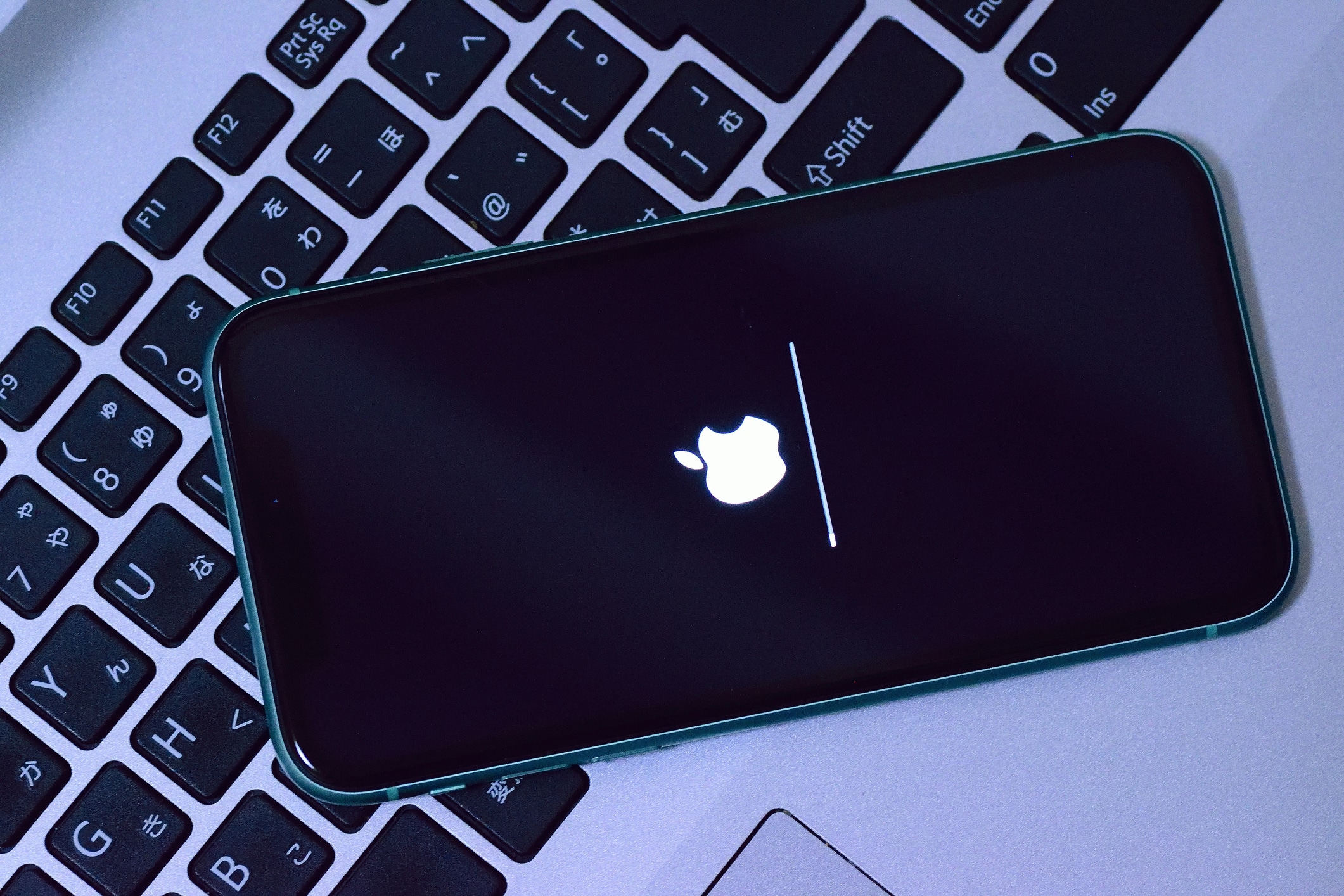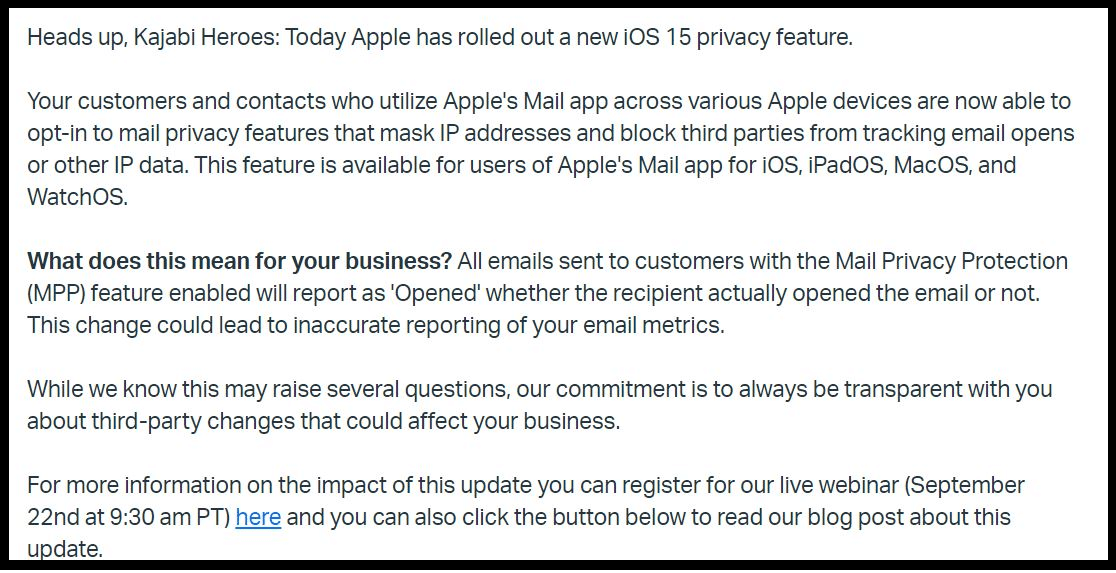What iOS 15 Means for Email Marketing

More than two million people watched the September 2021 Apple Event. While most of them had their eyes fixed on the new iPhone, marketers were focused on the privacy changes connected with the new iOS.
Related Reading: The Ultimate Guide to Email Automation for eCommerce
Privacy Features on iOS 15
Apple emphasized how much they care about privacy in the changes they introduced with their latest iOS update, which became available last September 20.
Your map history, for example, won’t be recorded and is not associated with your Apple ID. And you’ll get to see how much data apps can use and how they’re going to use them before you even hit download.
This is all well and good for users, but marketers are dependent on these data to get relevant metrics. It’s a big enough deal that email marketing companies are preparing their clients for the changes. Here’s an email from Kajabi.
This obviously applies only to Apple users. But Litmus.com analyzed over 12 billion email opens and determined that the top email client is Apple iPhone, and the most popular device for opening emails is mobile, with 90 percent opened on an iPhone.
This is why these changes are important to marketers, and we’re expecting Apple to continue to push for more privacy features in their next iOS releases.
Let’s talk about the two most important email privacy updates of iOS 15: Hide My Email and Mail Privacy Protection.
Hide My Email
What It Does: Generates random email addresses so users can hide their real emails.
How It Works:
Whenever an email is sent to the randomly generated address, it’s still received in the inbox of the primary email. However, they can always choose to block email forwarding or delete the random email for good.
Hide My Email can be used in two ways:
- Sign In with Apple
- iCloud+
If users opt for the Hide My Email option with Sign In with Apple, only that website or app can use the randomly generated email.
On the other hand, users who have iCloud+ can generate as many random email addresses as they want on their devices.
This is a bit confusing because to have iCloud+, the user needs to pay a premium fee while Sign In with Apple is free. The difference is that in iCloud+, users are allowed to generate random addresses for any purpose while in the latter, the Hide My Email feature is only for sign-up purposes.
How It Affects Email Marketers:
Getting people’s emails is already a task in itself. You have to provide something valuable to make people sign up for your newsletters. We spend time writing articles, making videos, recording podcasts, etc.
With the Hide My Email feature, what you may end up capturing is a random email address that the user can then get rid of. And that address will remain on your email list. And because iOS 15 will also give false opens (more on this later), it will be harder to clean your list.
Mail Privacy Protection
What It Does: It prevents senders from seeing if and when users have opened an email. It also hides the IP address to avoid anyone from linking it to online activities and determining the user’s location.
How It Works:
If you didn’t know already, email marketers use what’s called web beacons to determine if their emails have been opened. This is usually done through images with unique addresses. Receivers don’t necessarily have to see any image because they’re very small, usually 1 pixel by 1 pixel.
When the receiver opens the email, the image is loaded from the servers to let the system know that the email was opened. For those who don’t want senders to know if they’ve opened an email, they can easily do this by disabling automatic image loading. This way, when they open an email, they are given the option to display the images (in which case the opening is detected) or just read the content without loading the images.
With the new Mail Privacy Protection, Apple devices load these images even if they haven’t been opened yet. The good news is this works only if the receiver uses the native Apple Mail, without regard to the mail service.
How It Affects Marketers
Mail Privacy Protection leads to false opens that cause your email marketing software to report inaccurate data. So unless you have another way of determining for sure when an email has been opened, don’t read too much into your open rates. You’re expected to see a spike, but that doesn’t necessarily mean your emails are doing better.
What Can Marketers Do Now?
With the changes brought by iOS 15, email marketers will now have a hard time
- Cleaning out their email lists
- Running successful automation and flows
- Determining actual open rates
- A/B testing subject lines
- Geographically profiling subscribers
Here are just a few things email marketers can do:
Focus on other metrics.
Open rates are important, but so are click rates, bounces, and unsubscribes. These weren’t affected by the iOS 15 update, and they’re honestly better metrics to focus on because they tell you more about customer engagement than open rates do. Improve your email copy and make your CTAs more engaging.
Build trust by providing valuable content.
Subscribers may be less likely to hide their emails when signing up for a site they already trust. So keep putting out more valuable content to keep your audience engaged.
Consider doing polls and sending reconfirmation emails.
By doing so, you can have an idea about how many subscribers are really reading your emails. You can even ask them about the type of device they use.
Conclusion
Email remains to be one of the most effective ways of obtaining and nurturing customers, so it’s here to stay despite these changes. Marketers just have to be more resourceful in order to adapt.
What do you think of the iOS 15 update? Tell us in the comments section.







